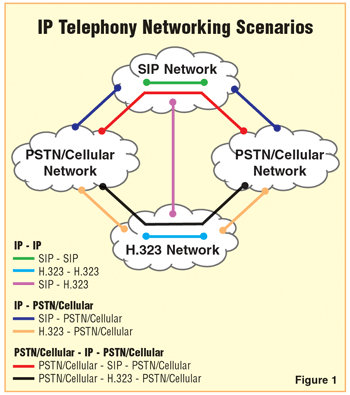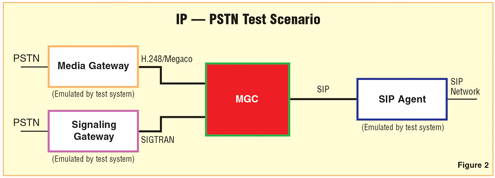|

July 2002
Steps For Success In Testing IP Telephony
BY GUY SIMPSON
Phenomenal growth in the IP sector is reshaping the future of voice
traffic, driving the integration of multimedia, and leading to network
convergence. Network equipment manufacturers and service providers are
rapidly creating IP telephony products and services, deploying them into the
marketplace even as IP standards continue to evolve. To be successful,
equipment manufacturers must ensure that their new products are compliant
with the appropriate standards, are compatible with other network devices
and can provide the necessary performance. The complexity of today�s
networks � owing to their greater size, their need to support rapidly
evolving communication standards, and the dictates of legacy infrastructure
� makes testing network equipment more challenging than ever.
Faced with this challenge, what measures need to be taken in order to
deliver IP telephony products that integrate smoothly and perform reliably?
Although there are many approaches to testing, the following steps are
almost always required for success:
- Verify features and functions. As IP products have become more
complex, basic product testing has become more critical than ever. Each
design feature must be individually checked and each function must be
individually proven to work. Typically this is done by comparing the
manufacturer�s product design specifications against the operating
characteristics of the product under development.
- Confirm compliance with industry standards. Today IP standards
are mainly being set by the Internet Engineering Task Force (IETF) and
the International Telecommunication Union (ITU). Products must be tested
for compliance with the relevant specifications produced by these
organizations. If compliance can be shown, a first level of confidence
can be established that the product can work with other
standards-compliant equipment. One way to confirm compliance to
standards is to use a third party to provide an independent assessment.
Standards are being revised and upgraded frequently so attention to this
topic must be ongoing.
- Verify network interoperability. New IP products must
communicate with network nodes that may be produced by multiple vendors.
One approach to interoperability testing is to buy or lease those
network node products � sometimes a prohibitively expensive
proposition. A more economical approach is to acquire a test system that
can emulate those same network nodes. Strong interoperability testing in
the lab generally spells interoperability in the field.
- Load-test the product. Networks are expanding in size and
traffic loads are growing rapidly. So a critical question is: �What is
the load capacity of a new product and what happens when that load is
exceeded?� By using an appropriate test system, the new product can be
driven to produce load data. Moreover, the test system can be used to
stress-test the product to determine when load saturation occurs and
what happens when that saturation level is exceeded. Based on this data,
the manufacturer can determine whether the new product can handle the
required load or not.
- Perform installation and acceptance testing. It is impossible
to test everything in a laboratory environment, and the risk of real
world surprises can be great. So even though a new product passes the
above tests in the laboratory equipment, a test system can be used to
further test and/or monitor the new product as it is being installed in
the field. Appropriate beta testing and phased roll-outs are accepted
ways to reduce the risks of field deployment.
Today, both H.323 and Session Initiation Protocol (SIP) standards coexist
in the IP world. This coexistence adds complexity in that IP telephony
networks must be able to support a variety of networking scenarios. Besides
supporting IP to IP communications, both H.323 and SIP networks must be able
to interwork with legacy Public Switched Telephone Networks (PSTN) and
advanced cellular networks. This interworking involves a variety of call
scenarios (Figure 1).

For example, consider a manufacturer that is developing a SIP Media
Gateway Controller (MGC) to provide IP internetworking with the PSTN
network. The MGC must communicate with the other SIP network nodes such as
the Media Gateway, Signaling Gateway, and SIP Agent. Recognizing the limited
time and resources available to develop internal test tools, the
manufacturer has acquired a third-party system to emulate these nodes
(Figure 2). As usual, there is heavy pressure to get the new MGC to market
as soon as possible. Nevertheless, the manufacturer is committed to quality
and will not stint on the necessary testing steps.

Step 1. Verify the features and functions of the MGC. The new MGC
must perform the required features and functions of a MGC including, for
example, registration, admission, and resource allocation. By using the test
system to simulate a SIP Agent, a Signaling Gateway, and a Media Gateway,
the manufacturer can test the MGC in a standalone environment.
Step 2. Confirm that the MGC complies with industry standards.
More specifically, the MGC must conform to the signaling protocol (SIP), the
signaling transport protocol (SIGTRAN), and the media gateway control
protocol (H.248/Megaco). Without this conformance the new product is very
likely be a proprietary solution with career limiting implications. By
building the required SIP, SIGTRAN, and H.248/Megaco protocols on the test
system, the manufacturer can perform the necessary tests to prove protocol
compliance.
Step 3. Test that the MGC can support interoperability between the
IP network and the PSTN. Instead of spending the time to develop internal
test tools or the money to purchase the actual network equipment, the
manufacturer can use the third-party test system to emulate a SIP Agent (to
establish SIP calls), a Signaling Gateway (to generate SIGTRAN signaling),
and Media Gateway (to create IP traffic). These emulations allow the
manufacturer to quickly and cost-effectively confirm interoperability.
Step 4. Test the traffic-handling capability of the MGC. The new
MGC must be able to support a required level of traffic. The test system can
be used to monitor the performance of the MGC under varying load conditions.
By analyzing the data in terms of BHCA (Busy Hour Call Attempts), MPS
(Messages Per Second), and TPS (Transactions Per Second), the manufacturer
can determine whether or not the MGC can meet the required load levels and
what will happen under extreme load.
Step 5. Test the MGC as it is being installed in the field. The
test system can be used to monitor the performance of the MGC after it is
installed into the network and to perform additional product, compliance,
and interoperability tests as necessary.
Each of these five steps is time and resource intensive. Manufacturers
may be tempted to develop internal tests. However, for a variety of reasons
� i.e., the growing complexity of the tests that are required, the desire
for an independent assessment, and the urgency of getting to market � the
acquisition of external test tools is often the best approach. Accordingly,
manufacturers should heed the old adage: �Get the right tool for the job.�
By availing themselves of today�s advanced network test tools,
manufacturers can reconcile time-to-market pressures with the accelerating
pace and complexity of new networking standards. As a result, products can
get to market faster and better meet customer expectations.
Comprehensive testing is the only way to ensure that IP-based network
equipment will perform reliably in real world networks. There is no better
ROI than to find and resolve issues such as feature shortcomings, protocol
non-conformance, interoperability problems, and load limitations throughout
the product life cycle. The complexity of today�s networks and the
dictates of legacy infrastructures make testing network equipment more
challenging than ever � but with the right test methodology and the right
test tools, success can be achieved.
Guy Simpson is vice president of applications development at Catapult
Communications. Catapult Communications provides advanced test systems to
equipment manufacturers and service providers for the design, integration,
installation, and acceptance testing of a broad range of digital
telecommunications equipment and services. For more information, visit the
company�s Web site at www.catapult.com.
[ Return
To The July 2002 Table Of Contents ]
|

